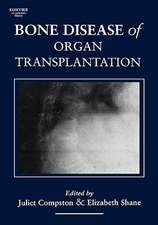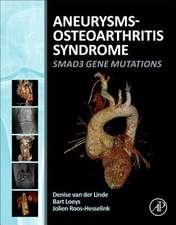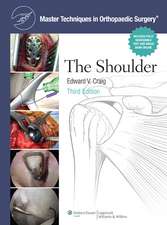Perspectives in Total Hip Arthroplasty: Advances in Biomaterials and their Tribological Interactions: Woodhead Publishing Series in Biomaterials
Editat de Saverio Affatatoen Limba Engleză Hardback – 7 apr 2014
Part one outlines the history of total hip arthroplasty and goes on to explore advances in techniques and biomaterials. Part two focuses on the tribology of materials used to perform this procedure, explaining the impact of wear on the load-bearing surface, a major cause of failure in hip prostheses. Chapters review a range of materials, including modern biomaterials, hybrid materials, metal, ceramic, and polyethylene. The book also discusses the tribological interactions of these materials when used in total hip arthroplasty.
Perspectives in Total Hip Arthroplasty is a key resource for clinicians, researchers, and academics interested in the tribology of total hip arthroplasty, as well as materials researchers, engineers, and academics concerned with the tribology of biomaterials.
- Covers techniques from innovative surgeons and designs from multinational manufacturers, as well as information on improvements in technologies and biomaterials
- Discusses the tribology of all the major materials used in total hip arthroplasty
Din seria Woodhead Publishing Series in Biomaterials
- 5%
 Preț: 1209.61 lei
Preț: 1209.61 lei - 9%
 Preț: 1288.81 lei
Preț: 1288.81 lei - 20%
 Preț: 1116.12 lei
Preț: 1116.12 lei - 36%
 Preț: 1030.16 lei
Preț: 1030.16 lei - 5%
 Preț: 1403.92 lei
Preț: 1403.92 lei - 26%
 Preț: 990.05 lei
Preț: 990.05 lei - 5%
 Preț: 1047.40 lei
Preț: 1047.40 lei - 5%
 Preț: 1097.68 lei
Preț: 1097.68 lei - 36%
 Preț: 847.30 lei
Preț: 847.30 lei - 9%
 Preț: 1159.07 lei
Preț: 1159.07 lei - 5%
 Preț: 1341.04 lei
Preț: 1341.04 lei - 5%
 Preț: 1116.94 lei
Preț: 1116.94 lei - 5%
 Preț: 1115.67 lei
Preț: 1115.67 lei - 20%
 Preț: 901.66 lei
Preț: 901.66 lei - 5%
 Preț: 1114.31 lei
Preț: 1114.31 lei - 26%
 Preț: 903.89 lei
Preț: 903.89 lei - 36%
 Preț: 939.94 lei
Preț: 939.94 lei - 5%
 Preț: 1511.72 lei
Preț: 1511.72 lei - 5%
 Preț: 1071.15 lei
Preț: 1071.15 lei - 9%
 Preț: 1090.57 lei
Preț: 1090.57 lei - 9%
 Preț: 1044.12 lei
Preț: 1044.12 lei - 9%
 Preț: 1003.98 lei
Preț: 1003.98 lei - 5%
 Preț: 1050.99 lei
Preț: 1050.99 lei - 5%
 Preț: 1600.80 lei
Preț: 1600.80 lei - 5%
 Preț: 986.00 lei
Preț: 986.00 lei - 5%
 Preț: 1118.83 lei
Preț: 1118.83 lei - 5%
 Preț: 1050.99 lei
Preț: 1050.99 lei - 20%
 Preț: 1038.08 lei
Preț: 1038.08 lei - 5%
 Preț: 902.90 lei
Preț: 902.90 lei - 9%
 Preț: 1070.42 lei
Preț: 1070.42 lei - 5%
 Preț: 1512.75 lei
Preț: 1512.75 lei - 29%
 Preț: 1282.87 lei
Preț: 1282.87 lei - 25%
 Preț: 1121.07 lei
Preț: 1121.07 lei - 5%
 Preț: 1253.32 lei
Preț: 1253.32 lei - 9%
 Preț: 1204.85 lei
Preț: 1204.85 lei - 26%
 Preț: 1046.86 lei
Preț: 1046.86 lei - 5%
 Preț: 835.44 lei
Preț: 835.44 lei - 5%
 Preț: 838.79 lei
Preț: 838.79 lei - 5%
 Preț: 940.93 lei
Preț: 940.93 lei - 20%
 Preț: 1290.67 lei
Preț: 1290.67 lei - 5%
 Preț: 940.63 lei
Preț: 940.63 lei - 5%
 Preț: 1115.22 lei
Preț: 1115.22 lei - 5%
 Preț: 989.25 lei
Preț: 989.25 lei - 20%
 Preț: 1598.75 lei
Preț: 1598.75 lei - 20%
 Preț: 964.40 lei
Preț: 964.40 lei - 20%
 Preț: 903.00 lei
Preț: 903.00 lei - 5%
 Preț: 1333.41 lei
Preț: 1333.41 lei
Preț: 847.49 lei
Preț vechi: 1185.81 lei
-29% Nou
Puncte Express: 1271
Preț estimativ în valută:
162.22€ • 176.26$ • 136.35£
162.22€ • 176.26$ • 136.35£
Carte tipărită la comandă
Livrare economică 14-28 aprilie
Preluare comenzi: 021 569.72.76
Specificații
ISBN-13: 9781782420316
ISBN-10: 1782420312
Pagini: 182
Dimensiuni: 156 x 234 x 20 mm
Editura: ELSEVIER SCIENCE
Seria Woodhead Publishing Series in Biomaterials
ISBN-10: 1782420312
Pagini: 182
Dimensiuni: 156 x 234 x 20 mm
Editura: ELSEVIER SCIENCE
Seria Woodhead Publishing Series in Biomaterials
Cuprins
- Author contact details
- Woodhead Publishing Series in Biomaterials
- Foreword
- Introduction
- Part I: Advances in total hip arthroplasty (THA) techniques and biomaterials
- 1. The history of total hip arthroplasty (THA)
- Abstract:
- 1.1 Human hip anatomy
- 1.2 Kinematics of the hip
- 1.3 Biomechanics of the hip
- 1.4 History of total hip arthroplasty
- 1.5 Indications for total hip arthroplasty
- 1.6 References
- 2. The history of biomaterials used in total hip arthroplasty (THA)
- Abstract:
- 2.1 The history of biomaterials used in total hip arthroplasty (THA)
- 2.2 Current THA materials and techniques
- 2.3 Polymers in THA
- 2.4 Metals in THA
- 2.5 Ceramics in THA
- 2.6 References
- 3. Historical techniques and designs in total hip arthroplasty (THA)
- Abstract:
- 3.1 Introduction
- 3.2 Surgical approaches to total hip arthroplasty (THA)
- 3.3 Posterolateral surgical approach to THA
- 3.4 Anterolateral surgical approach to THA
- 3.5 Anterior surgical approach to THA
- 3.6 Success rate in post-op rehabilitation
- 3.7 Minimally invasive surgery (MIS)
- 3.8 References
- 4. Contemporary designs in total hip arthroplasty (THA)
- Abstract:
- 4.1 Total hip arthroplasty (THA)
- 4.2 Hip joint diseases and fracture-related problems
- 4.3 Modern trends in hip joint prosthesis
- 4.4 Fixation methods
- 4.5 The femoral stem
- 4.6 The femoral head
- 4.7 The acetabular cup
- 4.8 Selecting prosthesis designs to suit individual patient needs
- 4.9 Possible complications, factors influencing durability and failures
- 4.10 Arthroplasty registers
- 4.11 Conclusions
- 4.12 References
- 5. Fixation techniques of total hip arthroplasty (THA) components
- Abstract:
- 5.1 Introduction
- 5.2 Cemented techniques
- 5.3 Cementless techniques
- 5.4 Hybrid techniques
- 5.5 Selecting patient-specific techniques
- 5.6 Causes of implant failure
- 5.7 Conclusions
- 5.8 References
- 6. Recent developments and future trends in total hip arthroplasty (THA)
- Abstract:
- 6.1 Introduction
- 6.2 Advances in biomaterials and prosthetic design
- 6.3 Hip resurfacing
- 6.4 Complications
- 6.5 Modern trends
- 6.6 Conclusions
- 6.6 References
- 1. The history of total hip arthroplasty (THA)
- Part II: Tribological interactions of biomaterials for total hip arthroplasty (THA)
- 7. Tribological interactions of modern biomaterials used in total hip arthroplasty (THA)
- Abstract:
- 7.1 Friction and wear factors
- 7.2 Lubrication
- 7.3 Testing for wear in vivo and in vitro
- 7.4 Diagnosis and surveillance
- 7.5 Failure analysis
- 7.6 References
- 8. Tribological interactions of polyethylene in total hip arthroplasty (THA)
- Abstract:
- 8.1 Introduction
- 8.2 Biological reactions to orthopaedic implant degradation products of polyethylene
- 8.3 The effectiveness of lubrication on wear and friction of bearings
- 8.4 Bearing performances
- 8.5 References
- 9. Tribological interactions of metal in total hip arthroplasty (THA)
- Abstract:
- 9.1 Introduction
- 9.2 Biological reactions to orthopaedic implant degradation products of metal
- 9.3 The effectiveness of lubrication on wear and friction of bearings
- 9.4 Bearing performances
- 9.5 References
- 10. Tribological interactions of ceramic bearings in total hip arthroplasty (THA)
- Abstract:
- 10.1 Introduction
- 10.2 Biological reactions to orthopaedic implant degradation products of ceramic bearings
- 10.3 The effectiveness of lubrication on wear and friction of bearings
- 10.4 Bearing performances
- 10.5 References
- 11. Tribological interactions of hybrid hard bearings in total hip arthroplasty (THA)
- Abstract:
- 11.1 Introduction
- 11.2 Biological reactions to orthopaedic implant degradation products of hybrid hard bearings
- 11.3 The effectiveness of lubrication on wear and friction of bearings
- 11.4 Bearing performances
- 11.5 References
- 7. Tribological interactions of modern biomaterials used in total hip arthroplasty (THA)
- Index







